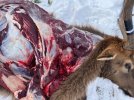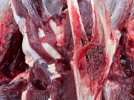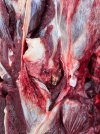I believe that we can all safely agree that bullet failures can and do occur regardless of bullet type, but in the OP's specific situation here, the question we must ask is could this failure have been avoided by simply unclogging the tip? Does anyone have any controlled test results showing expansion of clogged vs. unclogged tips?
Regardless of how a specific bullet is marketed - as a target or hunting bullet - what we call hunting failures are going to occur due to the infinite numbers of scenarios, environmental conditions, etc., that the bullet encounters when impacting the specific point of the game animal it strikes.
I had a situation this year where I encountered a bull elk at 75 yards. I was kneeling down peering through a small hole on a very steep spine in the timber. The bull was staring me down. I sat motionless hoping that he would move to an area that offered a better shot angle and opening. After watching the bull for several minutes, I made the choice to shoot the bull right on the shoulder. He was quartering too slightly, and my thoughts were that I wanted to anchor him on the spot to ensure that he didn't run down the steep slopes on both sides of the spine. I had plenty of time to think about the shot and how to proceed.
I was running 208 ELD-M's with my 300 win mag. Yes, I know that these are "target bullets"... Per my ballistics program, the bullet speed at impact was at about 2850 FPS and it was carrying about 3700+ ft-lbs of energy. I hit him right on the point of the shoulder - in the thick part of the humerus where it connects to the scapula.
Just as I anticipated, the bull dropped in his tracks. Looking up through the steep-timbered slope, I could see all 4 of his hooves kicking in the air. The bull was basically flat on his back. This lasted for about 5-10 seconds and the kicking stopped. It was very cold so I grabbed my gloves and put them on and started reaching for my pack that sat beside me. After putting my gloves on, I glanced up again, and noticed antlers moving from where he fell. The bull gathered himself and walked to my right across the slope into an opening. I could see him standing there in the wide open. He was still quartering too me which wasn't ideal. I was dumbfounded as to why he got up and was questioning whether is was even the same elk. I looked through my scope and noticed a small trickle of blood coming down his shoulder confirming that it was the same elk that I had shot. This time I had to act quick as I knew he was wounded. Since he was still quartering to me, I chose a spot between the shoulder and neck, hoping to sneak it into his vital area. The bullet hit its mark just to the neck-side of the scapula and right of my original shot. This caused considerable damage to the lungs and the main portion of the jacket and some of the core ended up resting against the hide on the opposite side. After wobbling for just a few seconds, the bull fell over dead within a couple of feet from where he was standing.
When I deboned the elk, I discovered that the first bullet essentially bounced off the thick end of the humerus. I found absolutely no fractures in the bone. There wasn't even a nick in the bone and there was very little tissue damage. I discovered about 1/3 to 1/2 of the bullet. It penetrated about 2" and was sitting near the humerus in some muscle tissue. A core section of copper and lead about 3/4" in length was still intact, probably weighing about 40% of its original weight. The rest of the bullet was nowhere to be found. I assume that a few factors such as shot angle, high velocity, my questionable choice to try and break the shoulder, and bullet choice, etc., all contributed to the failure.
I am not trying to derail this thread or start another conversation about how one should or shouldn't use ELD'M's or Bergers for hunting, but rather just sharing my story of how I experienced a complete failure and near-perfect performance on the same elk over the course of just a minute of time. Strange things can happen.





